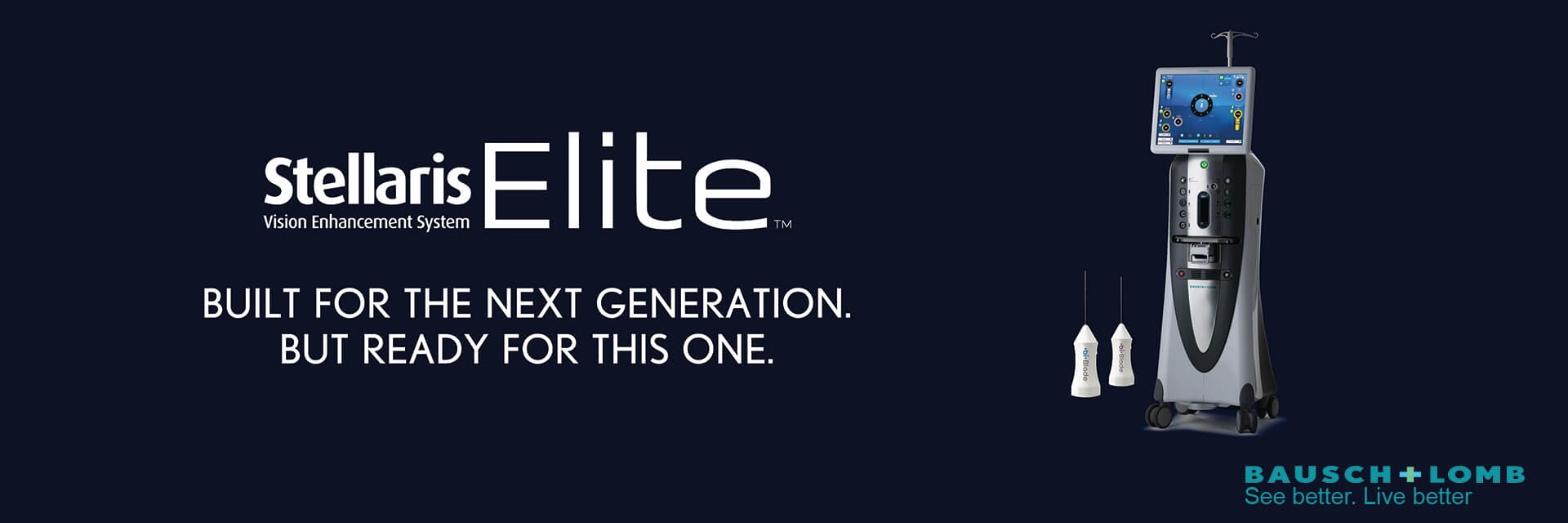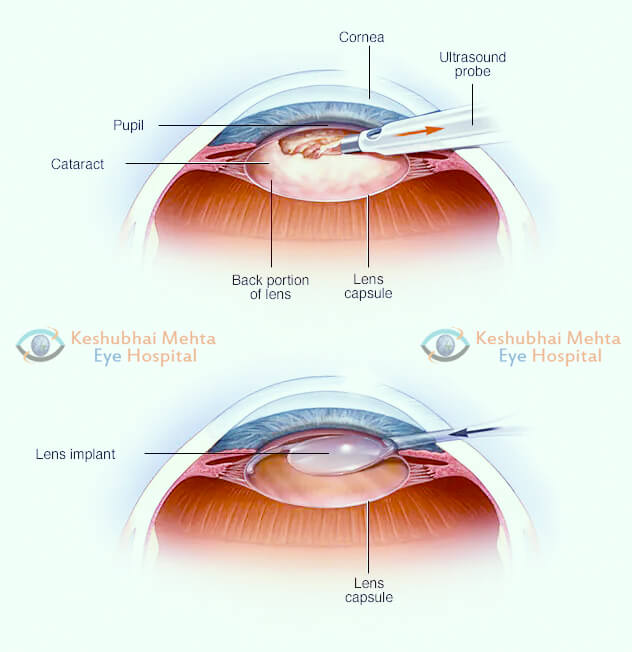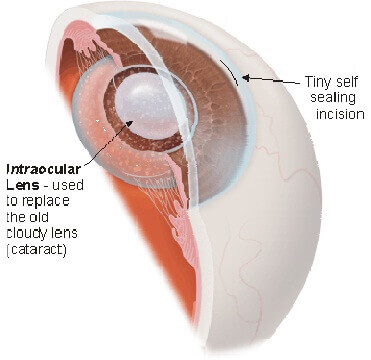
Cataract
Stitchless cataract surgery
In Phaco technique, a small incision is placed in the eye, and a hollow Phaco needle is introduced through the opening. On giving energy through the tip of the Phaco needle, the cataract lens gets dissolved and is sucked out through this needle. An artificial lens called a foldable Intra-ocular lens is now injected through this small opening. Once inside the eye, it opens up and serves to replace the original lens. Since the eye-opening is very small and designed specially, it self-seals, and no sutures are required. Hence this procedure is also popularly known as “Stitchless” cataract surgery.

Most cataracts are related to the natural aging of the eye. However, other factors can be involved. Some diseases, such as diabetes or glaucoma, or the use of certain medications, such as steroids, are thought to increase the chance of a cataract occurring. Often, a cataract only covers a small part of the lens; if sight is not greatly impaired there is no need to remove the cataract. However, if a large portion of the lens becomes cloudy, sight can be partially or completely lost until the cataract is removed.
Who can have a cataract?
Cataracts can occur at any age. Most cataracts occur in people who are 60 years of age or older, although a smaller number of people develop cataracts between the ages of 45 and 60. Some cataracts occur in children at birth due to genetic disorders or if the mother and rubella (German measles). Cataracts due to an injury can occur at any age.
Symptoms of cataracts
If you have cataracts you may not realize it right away. Vision loss may be gradual, painless, and hard to detect until a significant loss has occurred. Depending on the nature and cause, a cataract rapidly over a few months or slowly over many years. In older people, it is not unusual for cataracts to develop in both eyes but most of the time the cataract develops in only one eye at a time.
Choices of IOLs at Keshubhai Mehta Eye Hospital
Our clinic offers a wide range of intraocular lenses ( IOLs) that can be implanted after cataract surgery. All the IOLs used are either US FDA approved or Europe CE marked. Choices of IOLs that are available at Keshubhai Mehta Eye Hospital include Read More...
Some of the more common symptoms of cataracts include:
- Blurred vision
- Glare
- Fading or yellowing of colors
- Poor night vision
- Double vision in one eye
- Halos around lights
People with a cataract in only one eye may notice a loss of depth perception; this can cause problems in judging where stairs are and determining the distance of cars driving in front of them.
Types Of Cataract
- Age-related cataract: Most cataracts are related to aging. Congenital cataract: Some babies are born with cataracts or develop them in childhood, often in both eyes.
- These cataracts may not affect vision. If they do, they may need to be removed.
- Secondary cataracts: Cataracts are more likely to develop in people who have certain other health problems, such as diabetes.
- Also, cataracts are sometimes linked to steroid use. Traumatic cataract: Cataracts can develop soon after an eye injury, or years later.
How to check Cataract (Self Test)
- If you want to see, if you are beginning to form a cataract or if you are in an intermediate stage to a full-blown advanced degree of one there is a simple test that you can do at home. The test will reveal every level by allowing you to see for yourself the changes that are happening.
- To do the test all you need is a mirror. If you are having a difficult time seeing then you can ask a friend or a relative to help thus eliminating the need for the mirror at all because the other person will be your eyes and essentially you will be the test subject.
- Look in the mirror at the pupil, the black dot in the center of the eye, this will be the place where a cataract will form. What do you see? If you see a cloudy dot or haze anywhere in the pupil that is a cataract. Your eye pupil should be completely black to be cataract free. You may not see anything. Look for a color change in the pupil. If the pupil does not look completely black all over but you notice that part of it is misty or lighter colored than the rest chances are you have a cataract. You can do the test every day to check for any changes that may be taking place. That way if you do have a cataract you can check to see how bad it is getting daily or if it is getting worse at all. Sometimes the cataract appears dormant.
For the prevention of a cataract from sun exposure, there are a few things you can do.
- Wear a hat.
- Wear sunshades with UVA and UVB protection.
- Don't go outside when the heat index is high.
- Avoid lengthy stays outside by minimizing your time in the sun.
- Avoid tanning.
- Avoid sitting or lounging for long periods by water. Water will reflect the sun.
- Avoid sunburn of the eyes.
Diagnosis of Cataracts
A cataract is diagnosed by examining the inside of the eye with a Slit Lamp microscope. Once Diagnosed, a cataract can be removed at any time. When a cataract interferes with normal daily activities such as reading the newspaper. it may be time to discuss with Doctor an operation, to have the cataract removed.
Treatment
The most effective treatment for cataracts is an operation to remove the cloudy lens. Diets or drugs have not been shown to slow or stop the development of cataracts.
There are two types of surgeries available for Cataract removal

Extracapsular cataract surgery
- Wear a hat.
- Wear sunshades with UVA and UVB protection.
- Don't go outside when the heat index is high.
- Avoid lengthy stays outside by minimizing your time in the sun.
Phacoemulsification
- Known as phaco surgery
- Uses ultrasonic energy to cut, break and suck the cataract.
- Incision size varies from 0.9 to 3 mm
- No stitches hence no irritation
- less healing time, so early recovery
- less postoperative complication.
- No patch to cover the eye
- No injection anesthesia.
- No stitches


Advantages of Phacoemulsification
- There are no stitches.
- There is less trauma to the eye.
- Patients have improved vision sooner usually between 3 to 5 days.
- Patients can resume their daily activities almost immediately
When To Operate Cataract ?
In the past, eye specialists often waited until the cataract became “ripe” and your vision was very poor before suggesting that you had the cataract removed.
Nowadays, with modern surgery, the operation is usually done as soon as your eyesight interferes with your daily life and your ability to read, work, or do the things you enjoy. You will probably want to consider surgery if this is the case.
What to Expect On Cataract Surgery Day ?
Cataract surgery is the most frequently performed surgery and the most successful. Cataract surgery usually lasts for 15 to 2o minutes and is almost painless. During the operation, the lens containing the cataract is removed and replaced with a plastic lens, ie intraocular lens or IOL, so that the eye can see clearly after the operation. A lens implant (intraocular lens) inserted during cataract surgery allows the surgeon to correct nearsightedness or farsightedness. The time required for recuperation after cataract removal depends on the type of procedure performed and the patient’s rate of healing. The decision as to which procedure is best for an individual’s eye is made by the patient’s ophthalmologist.
Cataract surgery is one of the most successful operations. Fewer than two percent of patients have serious, unforeseen complications. One of the commonest, and most easily correctable, the complication is a thickening of the lens capsule – the part of the eye that holds the lens in place. As mentioned earlier, this can easily be corrected with laser treatment.


